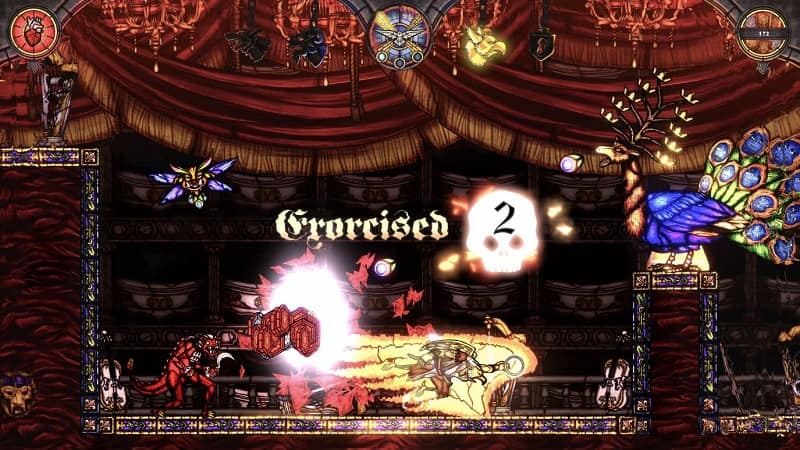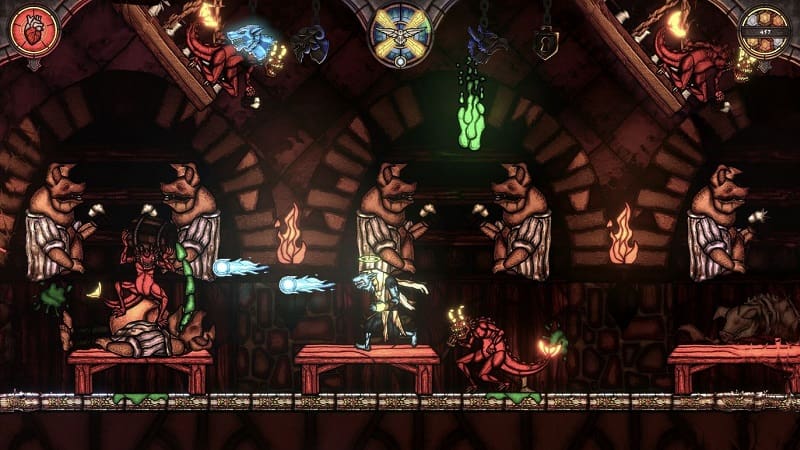Saga of Sins PS5 review. I think the first thing to probably say about Saga of Sins is that first and foremost, it isn’t a Metroidvania in the traditional sense – or at least not one that exists within the typical parameters for a title within that subgenre. No, instead what Saga of Sins actually is an action platformer with a super neat narrative hook and an even more stylish visual aesthetic, albeit one that is much more limited than its heady premise might initially suggest.
Saga Of Sins PS5 Review
A Strikingly Innovative But Ultimately Limited Action Platformer With Style To Spare
The setting of Saga of Sins is certainly a unique one – even among its more fantasy themed genre brethren. Players take control of Cecil, a troubled cleric returning from the Crusades looking for some peace in his home village of Sinwell (*no* village with that name is ever going to have much in the way of peace). Anyway, upon returning to this seemingly sleepy little hamlet he finds himself approached by the father of his local church who essentially informs him that the plague which has torn the village apart has been driven by the sins of its denizens and its up to dear Cecil to rid the humble townsfolk of their base desires.
Where things get especially spicy/blasphemous, is that in order to rid these poor souls of their sins as instructed by the wise father of Sinwell Church, you must invade the minds of these folks and manifest yourself as one of four demonic forms in order to ‘purge’ the sin from them entirely (which comes in the form of collecting a forbidden fruit from each mind) and well, things naturally escalate from there as you might well expect.
Viewed from a side-on, two dimensional perspective, Saga of Sins wastes no time in impressing both players and passive viewers alike with its astounding visual aesthetic. Inspired by the works of fifteenth century Dutch painter Hieronymus Bosch, Saga of Sins really does look like a stained glass kaleidoscope in motion that in particular gives the character models an almost marionette-like appearance which helps to underscore the more fantastical nature of its overarching narrative. To say that it looks unique would be something of an understatement to say the least.
Structurally, Saga of Sins is split into two distinct halves. The first has you walking the sin-stained streets of Sinwell as the increasingly anxious cleric Cecil speaking to the townsfolk and attempting to allay them of various sinful maladies that ail them. Though devoid of any real action, this section of Saga of Sins actually proves to still be oddly satisfying as you get to know each of the villagers (including, hilariously, Hieronymus Bosch himself) and poke your nose into their varying sin-stuffed lives. From the pervert sat at the bottom of the toilet well looking up hoping to catch a glimpse of some poor lady’s skirt, to a farmer that is doubling his prices owing to a lack of competition (thanks to the plague), there are no shortage of sinners for you to attempt to set on the right path.
You won’t just be chatting and leaping into the fractured minds of the sinners either. Also within Sinwell there are still a handful of innocents that are just trying to live their lives and so too can you leap into their minds but given that they haven’t, you know, sinned, the rewards for doing so are very different than what they are for hopping into the skulls of the more nefarious denizens of Sinwell. As you’re probably guessing by now, it’s when you start leaping into minds that the second half of Saga of Sins is brought to bear.
The goal for completing each ‘mind’ is simple – you just need to defeat the various monsters and evade the numerous traps that litter each level and collect the forbidden fruit that lay at the end. How you do this is by taking control of a demonic avatar that each has its own abilities that allow you to make this a reality. The first of these avatars, the werewolf, not only allows you shoot rapid magic bolts at foes, but so too does it have a special howl ability that allows it to reveal secret doors and chests that the other avatars wouldn’t be able to do. Likewise, the hippogriff avatar can be used to grapple climb onto certain surfaces that are unique to that particular avatar, thus permitting access to points in the level which the other avatars would not be able to reach.
Further Reading – Upcoming PS5 Games – The Most Anticipated PS5 Games Coming Soon In 2023
And then there is the power dash ability. Very similar to how it is used in Drinkbox Studios superb Guacamelee! games, in Saga of Sins each avatar possesses a common multi-directional power dash which can be used to thrust them at great speed and distance in a particular direction. Used for both killing lines of enemies extremely quickly (there are multiple trophies for doing just this) and landing on hard to reach ledges, it’s fair to say that the power dash is as much a key element of Saga of Sin’s action platforming shenanigans as any other aspect of its game design.
It’s also a pleasant surprise just how much of its platforming fundamentals that Saga of Sins gets right. Not only is the platforming welcomingly precise to the point that if you fail you know it’s you and not the game that caused the error, but so too is the side-scrolling shooter side of things snappy too, resulting in a compellingly satisfying experience as a direct result.
Where Saga of Sins ramps up the sophistication of its platforming challenges somewhat is in how it allows players to instantly switch between avatars with just a click of one of the shoulder buttons, meaning that you can have challenges in just one part of a given level which need you to switch between each avatar in quick succession. As such, what Saga of Sins presents is an enjoyable cocktail of platforming, combat and puzzle solving.
Further Reading – All PS5 Games At 120 FPS & 120 Hz – What PS5 Games Run At 120 FPS & 120 Hz In 2023
Throw in the power dash ability into the whole mix and there are occasions when Saga of Sins can prove quite challenging. The problem however, is that Saga of Sins isn’t otherwise really that challenging at all on the whole thanks to frequent checkpoints and an overall low level of difficulty. As such, genre stalwarts will ably carve their way pretty swiftly through the game’s already brief length, which clocks in at just over three hours for an initial completion and just under six hours for total completion.
Annoyingly, there is an issue where each time you die it keeps asking you if you want to restart the level from the last checkpoint or not. The problem is if you’re tearing through it you can easily click no by accident and erase your progress on that level. Surely, a much better solution would just be to assume that the player would want to retry the level and only then, if they don’t want to continue playing, allow them to quit the game on their own terms. As it is, it can be frustrating to lose a whole heap of progress because you pressed the wrong button on an accidental whim.
Speaking of total completion In addition to said the aforementioned bad apples, another reason to root around in the souls of the poor wretches of Sinwell is to hoover up the coins that are both dropped by defeated enemies and which can also be found in the various treasure chests that are dotted around the place. Used to upgrade existing abilities such as providing additional magic bolts, extra power dashes, more health and so on, these coins sadly represent not only the sole source of loot you’ll find in Saga of Sins, but also the only path for progression in the game as well.
Certainly, progression in general feels extremely narrow in that you can only gain coins which can then only be used in turn to upgrade the various skills available on a rather emaciated skill tree. There are no new tools, no new weapons or anything else to really speak of from a progression standpoint which makes Saga of Sins feel a lot more one note from a gameplay perspective than it otherwise would.
Further Reading – The Best PS5 Indie Games Ranked In 2023
Though each level, or mind, is self-contained, they are all designed to be revisited later on when you have the necessary abilities to reach every inaccessible part of that level that you weren’t able to access first time round. Thus, the Metroidvania comparisons come into play – but quite unlike other notable examples of the genre such as Hollow Knight and others, there is no one continuous map or world for you to backtrack through; just a series of isolated levels for you revisit as soon as you get the additional abilities to make it worthwhile to do so.
It’s also worth mentioning that the numerous boss encounters that are stuffed into Saga of Sins (one for each of the main sins, naturally) are all roundly entertaining affairs that if they don’t quite land from a design perspective, remain imaginative nonetheless. Never straying into repetitive territory, each boss fight always provides players with a fresh approach – whether that’s being locked in a mirrored room and having to fight with hostile reflections than manifest themselves in the physical world to a rapid-fire obstacle course that must be overcome while a boss chases Cecil, you certainly cannot accuse Saga of Sins of having repetitive boss fights.
Perhaps one of the strongest aspects of Saga of Sins design is the impressively bespoke theming that has gone into each of the levels. With each of the sinner’s minds correlating to a level that is tied into that sin, you begin to notice both how aesthetically and functionally each of these levels reflect the sin that they are supposed to represent.
Not only does each sin themed world have its own enemies but there are a wealth of unique hazards to deal with as well. The sloth world for example has a muddy surface that makes movement sluggish, while the envy world has enemies that can steal your gold. Coupled with the unique audiovisual presentation that each level boasts (the wrath levels have an especially decent thrumming rock soundtrack which builds to quite the ear-ringing crescendo). Brilliantly, the levels which belong to the minds of the innocents also have a certain uniqueness to them too. Entering the mind of a simple fellow called Egbert thrusts Cecil into a very rapid fire version of groundhog day, whereas entering the mind of a dog and there are barks, howls and teeth shaped platforms to jump on. Saga of Sins simply has a wealth of imagination on display that surpasses much seen elsewhere in the genre.
Though short and certainly limited in a number of ways, Saga of Sins nonetheless leaves an indelible impression. With no shortage of imagination and a solid grasp of action platforming fundamentals, Saga of Sins not only impresses but provides an eye-opening blueprint for where a hopefully much more content stuffed sequel could go next. As it is, Saga of Sins is a breathlessly stylish, though overly brief action platformer that boasts a compelling setting that everybody should check out.
Review code kindly provided by publisher.
Saga of Sins is out now on PS4 and PS5.





